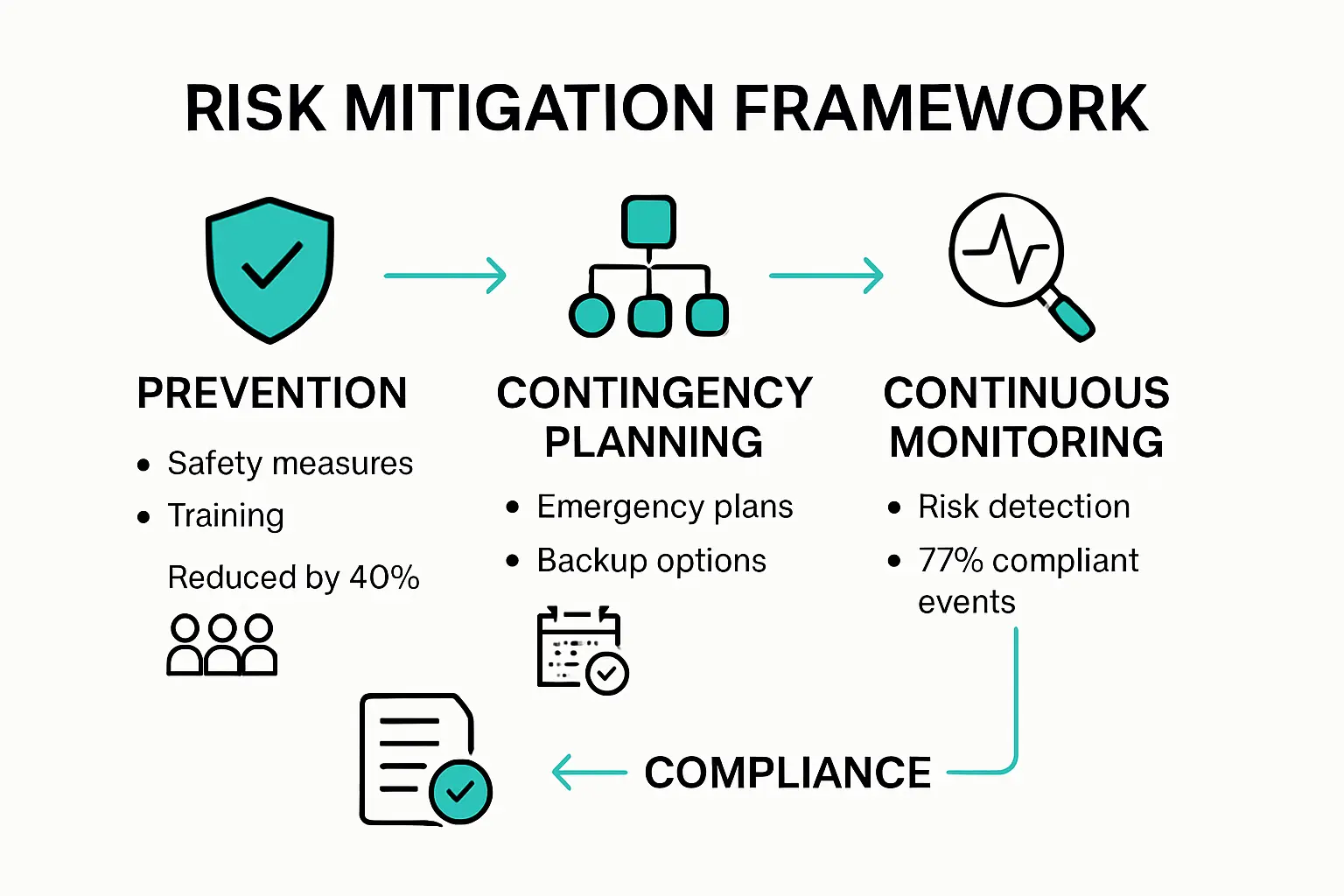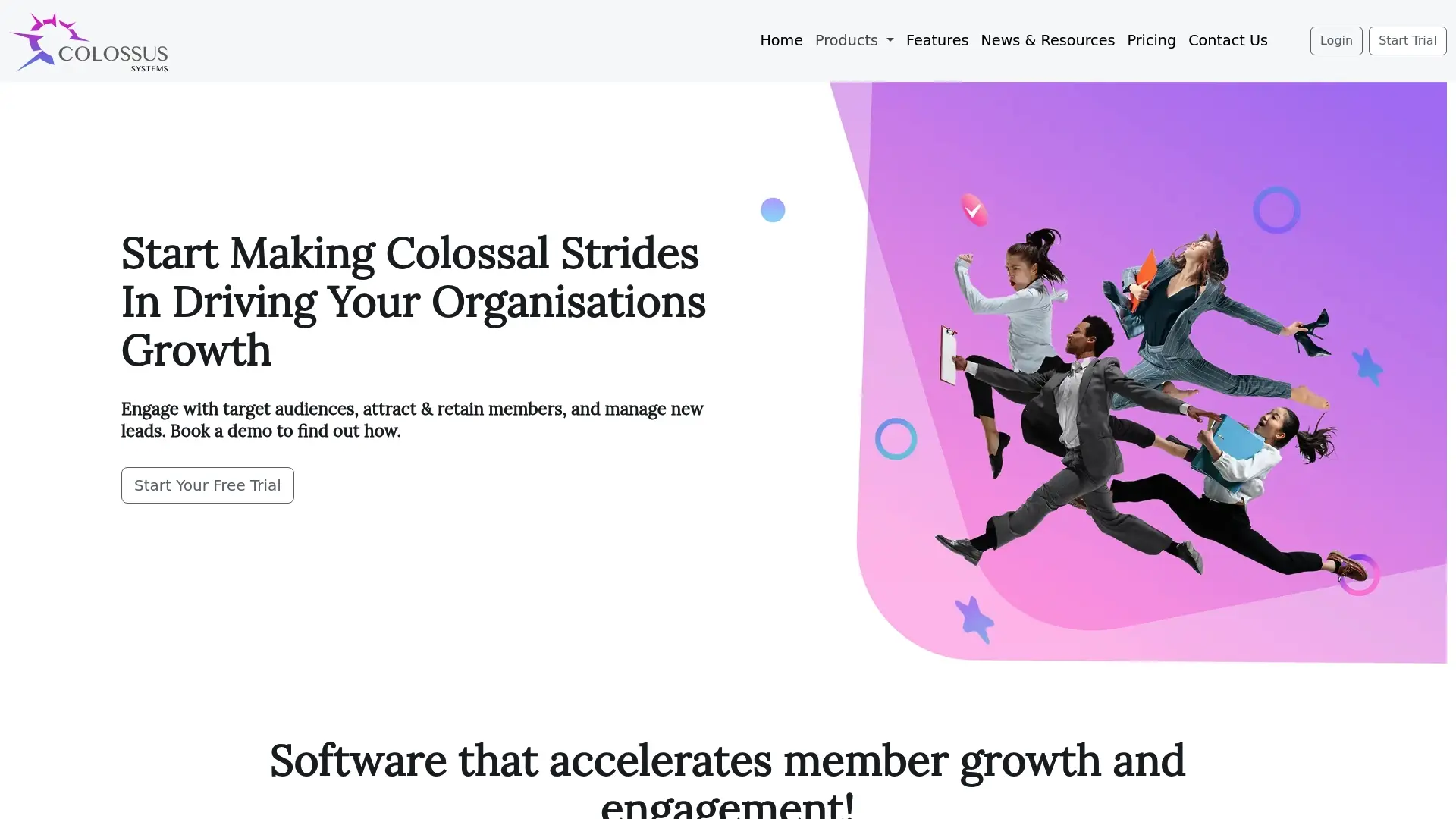Event Risk Management Strategies for Membership Organisations

Event risk management often sounds like a tedious checklist, yet it is the foundation that keeps membership organisations protected at every gathering. Statistically, events without a structured risk plan face a 40 percent higher chance of disruptions or safety incidents, which can damage reputation and finances in a single blow. Oddly enough, the strongest risk management strategies are not about reacting to disasters but about quietly preventing them before anyone even realises a problem was there.
Table of Contents
- Understanding Event Risk Management Essentials
- Identifying And Assessing Common Event Risks
- Implementing Effective Risk Mitigation Measures
- Creating A Culture Of Safety And Compliance
Quick Summary
| Takeaway | Explanation |
|---|---|
| Prioritise risk identification and assessment | Systematically evaluate potential risks to ensure comprehensive understanding and preparedness for events. |
| Implement ongoing risk mitigation strategies | Develop proactive measures that continuously evolve to respond to emerging risks and challenges effectively. |
| Cultivate a culture of safety and compliance | Foster an organisational commitment to safety principles ensuring all members actively participate in risk management. |
| Leverage technology for risk management | Utilize advanced digital tools for real-time monitoring, scenario simulation, and effective communication in risk situations. |
| Train staff for proactive risk awareness | Regularly educate staff and members on identifying and managing risks to create a resilient organisational culture. |
Understanding Event Risk Management Essentials
Event risk management represents a critical framework for membership organisations to protect their members, assets, and reputation during events. At its core, event risk management involves systematically identifying, assessing, and mitigating potential risks that could compromise event safety, financial stability, and overall organisational objectives.
Core Components of Event Risk Management
The process of event risk management begins with comprehensive risk identification. Explore our comprehensive event planning guide to understand the nuanced approach organisations must take. According to the Nonprofit Risk Management Center, organisations should develop a structured ten-step approach that includes establishing clear event goals, forming a dedicated risk management team, and implementing robust safety protocols.
Key risk identification strategies involve conducting thorough preliminary assessments that examine multiple potential threat categories. These typically include physical safety risks, financial vulnerabilities, legal compliance challenges, reputational dangers, and operational disruptions. Membership organisations must meticulously evaluate each potential scenario, understanding that comprehensive risk assessment goes far beyond mere compliance.
To help readers quickly compare the key categories of risks membership organisations need to consider, the following table summarises each main risk type alongside typical examples drawn from the article.
| Risk Category | Description | Examples |
|---|---|---|
| Physical Safety Risks | Risks related to injuries, accidents, or medical emergencies | Injuries, medical emergencies, venue hazards |
| Financial Risks | Risks involving financial instability or losses | Budget overruns, unexpected expenses, revenue shortfalls |
| Legal & Compliance Risks | Risks arising from regulatory issues or contractual obligations | Regulatory violations, contractual disputes, liability |
| Reputational Risks | Dangers to the organisation’s public image or member satisfaction | Negative publicity, dissatisfaction, brand damage |
| Operational Risks | Logistical, technological, or communication disruptions | Logistical issues, technology failures, communication breakdowns |
Strategic Risk Mitigation Techniques
Effective risk mitigation requires a proactive and multifaceted approach. The University of Nevada, Las Vegas provides insights into a systematic risk management process that involves several critical steps:
- Hazard Identification: Carefully map out potential risks specific to your event, considering venue characteristics, participant demographics, and planned activities.
- Impact Assessment: Evaluate the potential consequences of each identified risk, ranking them based on likelihood and potential severity.
- Mitigation Planning: Develop targeted strategies to either eliminate risks entirely or significantly reduce their potential impact.
Risk mitigation is not a one-time activity but an ongoing process requiring continuous monitoring and adaptation. Membership organisations must remain vigilant, regularly reviewing and updating their risk management strategies to address emerging challenges and changing environmental conditions.
Understanding event risk management is not about creating unnecessary bureaucracy but about creating a structured approach that protects both the organisation and its members. By implementing robust risk management strategies, membership organisations can create safer, more predictable event experiences that build trust and demonstrate professional commitment to participant wellbeing.
As BoardSource emphasizes, proactive risk management is essential for protecting an organisation’s mission and reputation. This involves not just identifying potential threats but developing comprehensive strategies that can be quickly implemented to mitigate unexpected challenges.
Identifying and Assessing Common Event Risks
Identifying and assessing event risks is a complex but crucial process for membership organisations that requires systematic analysis and strategic planning. Effective risk identification goes beyond simple checklists and demands a comprehensive understanding of potential challenges that could impact event success and organisational reputation.
Categories of Event Risks
Membership organisations encounter diverse risk categories that require nuanced evaluation. Learn more about comprehensive event planning to enhance your risk management strategy. According to The University of Florida’s risk management guide, risks can be categorized into several critical domains:
- Physical Safety Risks: Potential for injuries, accidents, medical emergencies, venue-related hazards
- Financial Risks: Budget overruns, unexpected expenses, revenue shortfalls, potential financial losses
- Legal and Compliance Risks: Regulatory violations, contractual disputes, liability concerns
- Reputational Risks: Potential negative publicity, member dissatisfaction, brand image damage
- Operational Risks: Logistical challenges, technology failures, communication breakdowns
Systematic Risk Assessment Methodology
The Nonprofit Risk Management Center recommends a structured approach to risk assessment that involves multiple strategic steps. This methodology emphasizes a comprehensive evaluation process that transforms risk identification from a reactive to a proactive practice.
Risk assessment begins with thorough documentation and detailed scenario planning. Organisations must develop comprehensive risk registers that meticulously document potential threats, their likelihood of occurrence, and potential impact. This process involves input from multiple stakeholders, including event planners, legal experts, safety professionals, and experienced members.
The following table outlines the fundamental steps in a systematic risk assessment methodology, as described in the article. This helps clarify each stage and its purpose for membership organisations.
| Assessment Step | Purpose |
|---|---|
| Risk Identification | Document all potential risks that might impact the event |
| Scenario Planning | Map potential situations where risks could materialise |
| Risk Register Creation | Collate detailed information on threats, likelihood, and impact |
| Stakeholder Input | Gather insights from planners, legal, safety experts, members |
| Risk Scoring/Ranking | Prioritise risks based on probability and potential consequences |
Quantitative and qualitative assessment techniques play a crucial role in understanding risk severity. Organisations should employ risk scoring matrices that evaluate potential threats based on two primary dimensions: probability of occurrence and potential consequences. This approach allows for prioritizing risks and allocating resources strategically.
Technology can significantly enhance risk assessment capabilities. Advanced risk management tools enable organisations to simulate potential scenarios, model potential outcomes, and develop responsive mitigation strategies. Digital platforms provide real-time monitoring and quick adaptation mechanisms that traditional risk management approaches cannot match.
Effective risk identification is not a one-time event but a continuous process of monitoring, evaluation, and adaptation. The University of Nevada, Las Vegas emphasizes the importance of creating dynamic risk management frameworks that can quickly respond to emerging challenges.
Ultimately, successful risk identification and assessment require a holistic approach that balances detailed analysis with practical implementation. Membership organisations must cultivate a risk-aware culture that empowers members and staff to proactively recognize and address potential challenges, transforming risk management from a compliance requirement into a strategic organisational strength.
Implementing Effective Risk Mitigation Measures
Implementing effective risk mitigation measures is a critical process that transforms theoretical risk assessments into practical, actionable strategies for membership organisations. The goal is not merely to identify potential risks but to develop robust, comprehensive approaches that prevent, manage, and minimize potential negative impacts.
Strategic Risk Mitigation Framework
According to EDUCAUSE Review, developing an effective risk mitigation strategy requires a systematic and holistic approach. Explore our comprehensive event planning resources to enhance your risk management capabilities. The fundamental framework involves several key strategic components:
- Prevention Strategies: Proactively designing interventions that eliminate or significantly reduce the likelihood of identified risks
- Contingency Planning: Developing detailed response protocols for potential risk scenarios
- Continuous Monitoring: Implementing real-time tracking and assessment mechanisms
Comprehensive Risk Response Techniques
The Nonprofit Risk Management Center emphasizes a multifaceted approach to risk mitigation that goes beyond simple reactive measures. Effective risk response involves a nuanced combination of strategic interventions:
Financial risk mitigation requires sophisticated planning. Organisations should develop comprehensive insurance coverage, establish financial reserves, and create detailed budgeting protocols that include contingency funding. This approach ensures financial resilience and protects the organisation from potentially devastating economic impacts.
Legal and compliance risk mitigation demands meticulous attention to regulatory requirements. This involves developing robust documentation processes, ensuring clear contractual agreements, and maintaining comprehensive records of all event-related interactions. Professional legal consultation can provide additional layers of protection and guidance.
Technology plays an increasingly critical role in risk mitigation. Advanced digital platforms enable real-time risk monitoring, rapid communication, and quick adaptive responses. The University of Nevada, Las Vegas highlights the importance of leveraging technological solutions to enhance risk management capabilities.
Training and education are fundamental to successful risk mitigation. Membership organisations must invest in comprehensive training programs that equip staff and members with the knowledge and skills necessary to identify, respond to, and manage potential risks. This creates a proactive risk-aware culture that extends beyond formal risk management protocols.
Effective communication represents another crucial aspect of risk mitigation. Organisations must develop clear, transparent communication channels that facilitate rapid information sharing during potential risk scenarios. This includes establishing emergency communication protocols, creating detailed communication trees, and ensuring multiple communication redundancies.

Ultimately, successful risk mitigation is not about eliminating all potential risks but about developing adaptive, resilient strategies that enable organisations to respond effectively to unexpected challenges. By combining comprehensive planning, technological innovation, continuous learning, and proactive approaches, membership organisations can transform risk management from a compliance requirement into a strategic organizational strength.
Creating a Culture of Safety and Compliance
Creating a culture of safety and compliance represents a fundamental strategic imperative for membership organisations. This approach transcends traditional risk management by embedding safety principles and regulatory awareness into the organisational DNA, transforming compliance from a bureaucratic requirement to a shared organisational value.
Foundational Elements of Safety Culture
Learn more about organisational safety strategies to enhance your approach. According to the National Center for Biotechnology Information, developing an effective safety culture requires several critical components:
- Leadership Commitment: Senior management must visibly demonstrate and prioritize safety principles
- Open Communication: Creating environments where members feel comfortable reporting potential risks
- Continuous Learning: Implementing ongoing training and development programmes
- Transparent Accountability: Establishing clear responsibility frameworks for risk management
Embedding Compliance as an Organisational Value
The Nonprofit Risk Management Center emphasizes that successful safety cultures are built on proactive engagement and systemic integration. This requires moving beyond reactive compliance to creating intrinsic motivation for safety and risk awareness.
Organisational leadership plays a pivotal role in cultivating safety consciousness. Executives and managers must model risk-aware behaviours, demonstrating that safety is not a peripheral concern but a core organisational principle. This involves making safety discussions a regular part of meetings, celebrating risk prevention efforts, and integrating safety metrics into performance evaluations.
Training programmes represent a critical mechanism for embedding safety culture. The American Society of Safety Professionals recommends comprehensive educational approaches that go beyond traditional compliance training. These programmes should focus on developing critical thinking skills, encouraging proactive risk identification, and creating scenarios that help members understand the practical implications of safety protocols.
Technology can significantly enhance safety culture implementation. Digital platforms can provide interactive training modules, real-time risk reporting mechanisms, and analytics that help organisations track and improve their safety performance. These tools transform safety from a static concept to a dynamic, continuously evolving organisational practice.
Effective communication strategies are fundamental to creating a robust safety culture. Organisations must develop multiple channels for risk communication, ensuring that members at all levels feel empowered to share observations, concerns, and potential improvements. This might include anonymous reporting systems, regular safety forums, and transparent feedback mechanisms.
Building a culture of safety and compliance requires patience, consistent effort, and a genuine commitment to protecting organisational and member interests. It is not about creating restrictive environments but about fostering a collective understanding that safety is a shared responsibility. By creating systems that encourage learning, accountability, and continuous improvement, membership organisations can develop resilient, proactive approaches to risk management.
Ultimately, a mature safety culture becomes a competitive advantage. It demonstrates an organisation’s commitment to its members, builds trust, and creates an environment where innovation can flourish without compromising fundamental safety principles.

Frequently Asked Questions
What are the core components of event risk management for membership organisations?
The core components include comprehensive risk identification, assessing potential risks, developing strategic mitigation techniques, implementing effective risk response measures, and fostering a culture of safety and compliance within the organisation.
How can membership organisations systematically assess event risks?
Membership organisations can assess risks by developing a structured risk assessment methodology, which includes identifying potential risks, scenario planning, creating a risk register, gathering stakeholder input, and scoring or ranking risks based on their likelihood and potential impact.
What strategies are effective for mitigating risks in events?
Effective risk mitigation strategies include hazard identification, impact assessment, prevention strategies, contingency planning, continuous monitoring, and leveraging technology for real-time risk management and communication.
How can technology enhance event risk management for membership organisations?
Technology can enhance event risk management by enabling real-time monitoring of risks, simulating potential scenarios, providing rapid communication tools, and improving overall response strategies to emerging risks.
Take the Stress Out of Event Risk Management With Colossus Systems
Membership events come with countless risks and the real challenge is balancing safety, compliance and member experience all at once. Your organisation needs a practical way to move from reactive, checklist-driven risk management to a system that actually prevents disruptions before they arise. But without the right tools, it is all too easy for event planning to feel overwhelming, with concerns about member safety, regulatory compliance, and reputational damage always lingering.

Why wait for problems to happen? Colossus Systems gives membership organisations a single, reliable platform for end-to-end risk management, integrated event planning, real-time communication and secure member engagement. Automate risk tracking, facilitate transparent communication and embed safety into every aspect of your event delivery. Visit Colossus Systems to see how you can simplify risk mitigation and create events with total confidence. Discover our comprehensive solutions for engagement and event management today, and make your next gathering as safe and seamless as possible.